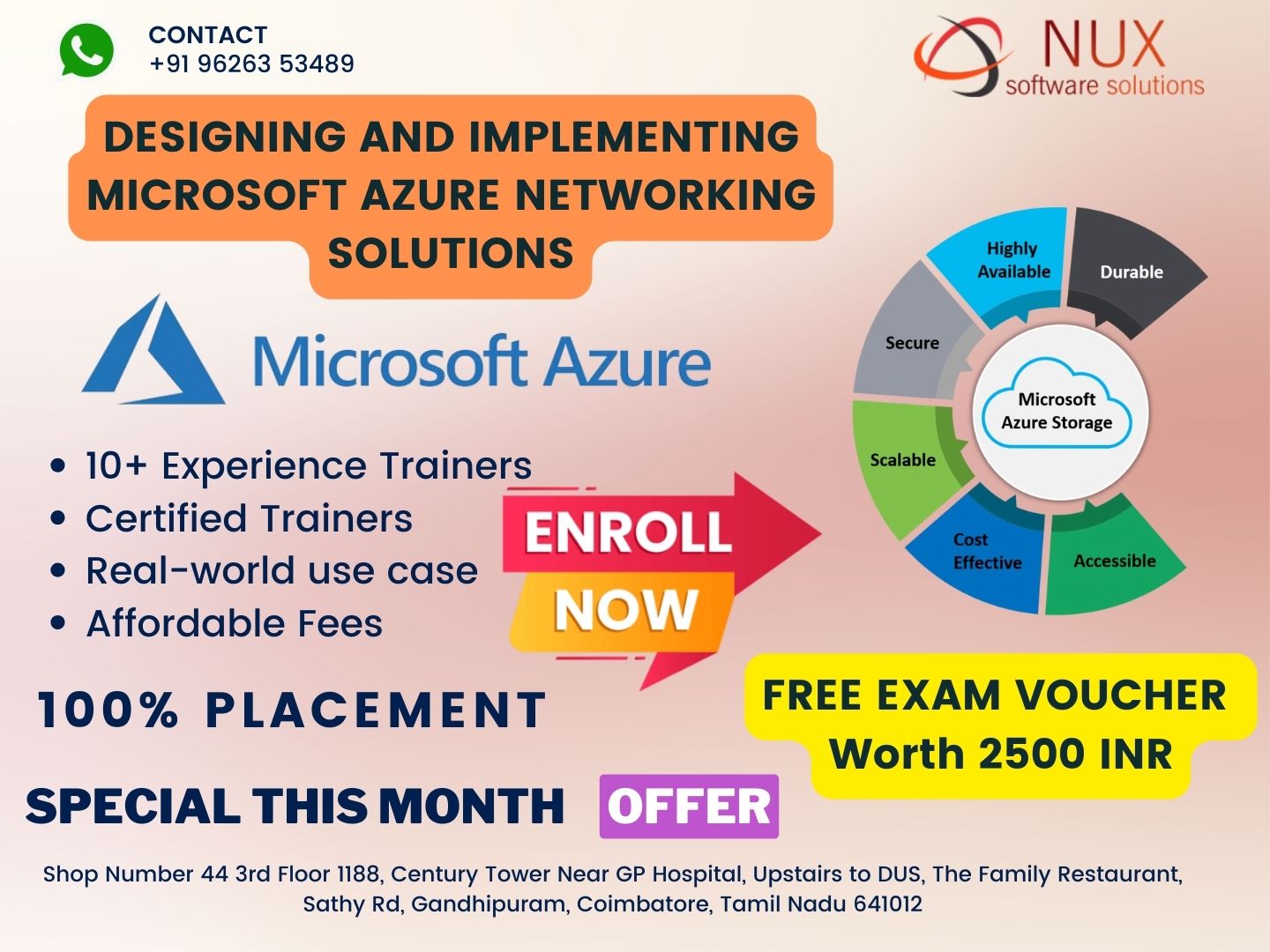Designing and Implementing Microsoft Azure Networking Solutions – AZ-700

AZ-700: Azure Networking Solutions Training in Coimbatore
Course Overview
The AZ-700 certification course, Designing and Implementing Microsoft Azure Networking Solutions, is tailored for network engineers and IT professionals who design, implement, and manage Azure network architecture. This course focuses on building secure, resilient, and high-performance network infrastructures using core Azure networking services.
At Linux Training Center in Coimbatore, this training program offers practical exposure to hybrid networking, routing, load balancing, private access, and network security—all aligned with the AZ-700 certification objectives.
Why Choose AZ-700?
As more organizations adopt cloud-first strategies, Azure networking skills are in high demand. This course empowers professionals to design and deploy scalable network solutions in Azure environments, integrate on-premises networks, and ensure connectivity and security in hybrid cloud models.
AZ-700 is the recommended certification for those aiming to specialize as Microsoft Certified: Azure Network Engineers, ensuring your career path aligns with modern infrastructure demands.
Who Should Enroll?
This course is ideal for network engineers, cloud infrastructure professionals, system administrators, and Azure solution architects involved in implementing networking solutions in cloud environments. It’s also well-suited for professionals preparing for the AZ-700 certification exam.
Learners should have a foundational understanding of Azure services and networking concepts such as IP addressing, DNS, VPNs, and firewalls.
What You Will Learn
Design and implement core networking infrastructure on Azure
Configure secure access to Azure resources using private endpoints and service endpoints
Set up hybrid connectivity with VPN Gateway and ExpressRoute
Implement Azure Firewall, Network Security Groups (NSGs), and DDoS protection
Design routing and load balancing solutions using Azure Application Gateway, Load Balancer, and Traffic Manager
Monitor and troubleshoot networking using Network Watcher and diagnostic tools
This course combines theory with hands-on labs to help learners build practical Azure networking skills.
Course Highlights
Microsoft-aligned curriculum for AZ-700 exam
Lab-based learning using Azure Portal and CLI
Sessions by certified Azure network specialists
Real-time implementation scenarios and use cases
Flexible batch timings including weekdays and weekends
Career Opportunities
Upon completion, you’ll be prepared for roles such as Azure Network Engineer, Cloud Network Architect, Infrastructure Consultant, or DevOps Engineer with a focus on networking. AZ-700 certification enhances your professional profile in enterprise and cloud-native IT environments.
Why Linux Training Center?
Linux Training Center in Coimbatore provides industry-relevant, instructor-led training designed to equip learners with real-world networking skills. With a focus on job readiness and hands-on experience, our Azure training helps you stay competitive in the evolving IT landscape.
AZ-700 Course Syllabus
Modules
Design and Implement Core Networking Infrastructure (25-30%)
Design and implement IP addressing for Azure resources
- Plan and implement network segmentation and address spaces- Create a virtual network (VNet)
- Plan and configure subnetting for services, including VNet gateways, private endpoints, service endpoints, firewalls, application gateways, VNet-integrated platform services, and Azure Bastion
- Plan and configure subnet delegation
- Plan and configure shared or dedicated subnets
- Create a prefix for public IP addresses
- Choose when to use a public IP address prefix
- Plan and implement a custom public IP address prefix (bring your own IP)
- Create a public IP address
- Associate public IP addresses to resources
Design and implement name resolution
- Design name resolution inside a VNet- Configure DNS settings for a VNet
- Design public DNS zones
- Design private DNS zones
- Configure public and private DNS zones
- Link a private DNS zone to a VNet
- Design and implement Azure DNS private resolver
Design and implement VNet connectivity and routing
- Design service chaining, including gateway transit- Implement VNet peering
- Implement and manage virtual networks by using Azure Virtual Network Manager
- Design and implement user-defined routes (UDRs)
- Associate a route table with a subnet
- Configure forced tunneling
- Diagnose and resolve routing issues
- Design and implement Azure Route Server
- Identify appropriate use cases for a network address translation (NAT) gateway
- Implement a NAT gateway
Monitor networks
- Configure monitoring, network diagnostics, and logs in Azure Network Watcher- Monitor and troubleshoot network health by using Azure Network Watcher
- Monitor and troubleshoot networks by using Azure Monitor Network Insights
- Activate and monitor distributed denial-of-service (DDoS) protection
- Evaluate network security recommendations identified by Microsoft Defender for Cloud Secure Score
- Evaluate network security recommendations identified by Microsoft Defender For Cloud Attack Path Analysis
- Identify network resources by using Microsoft Defender for Cloud Security Explorer
Design, implement, and manage connectivity services (20-25%)
Design, implement, and manage a site-to-site VPN connection
- Design a site-to-site VPN connection, including for high availability- Select an appropriate VNet gateway stock-keeping unit (SKU) for site-to-site VPN requirements
- Implement a site-to-site VPN connection
- Identify when to use a policy-based VPN versus a route-based VPN connection
- Create and configure a local network gateway
- Create and configure an IPsec/Internet Key Exchange (IKE) policy
- Create and configure a virtual network gateway
- Diagnose and resolve virtual network gateway connectivity issues
- Implement Azure Extended Network
Design, implement, and manage a point-to-site VPN connection
- Select an appropriate virtual network gateway SKU for point-to-site VPN requirements- Select and configure a tunnel type
- Select an appropriate authentication method
- Configure RADIUS authentication
- Configure authentication by using Microsoft Entra ID
- Implement a VPN client configuration file
- Diagnose and resolve client-side and authentication issues
- Specify Azure requirements for Always On VPN
- Specify Azure requirements for Azure Network Adapter
Design, implement, and manage Azure ExpressRoute
- Select an ExpressRoute connectivity model- Select an appropriate ExpressRoute SKU and tier
- Design and implement ExpressRoute to meet requirements, including cross-region connectivity, redundancy, and disaster recovery
- Design and implement ExpressRoute options, including Global Reach, FastPath, and ExpressRoute Direct
- Choose between Azure private peering only, Microsoft peering only, or both
- Configure Azure private peering
- Configure Microsoft peering
- Create and configure an ExpressRoute gateway
- Connect a virtual network to an ExpressRoute circuit
- Recommend a route advertisement configuration
- Configure encryption over ExpressRoute
- Implement Bidirectional Forwarding Detection
- Diagnose and resolve ExpressRoute connection issues
Design and implement an Azure Virtual WAN architecture
- Select a Virtual WAN SKU- Design a Virtual WAN architecture, including selecting types and services
- Create a hub in Virtual WAN
- Choose an appropriate scale unit for each gateway type
- Deploy a gateway into a Virtual WAN hub
- Configure virtual hub routing
- Integrate a Virtual WAN hub with a third-party NVA for cloud connectivity
Design and implement application delivery services (15-20%)
Design and implement Azure Load Balancer and Azure Traffic Manager
- Map requirements to features and capabilities of Azure Load Balancer- Identify appropriate use cases for Azure Load Balancer
- Choose an Azure Load Balancer SKU and tier
- Choose between public and internal load balancers
- Choose between regional and global load balancers
- Create and configure an Azure Load Balancer
- Implement Azure Traffic Manager
- Implement a gateway load balancer
- Implement a load balancing rule
- Create and configure inbound NAT rules
- Create and configure explicit outbound rules, including source network address translation (SNAT)
Design and implement Azure Application Gateway
- Map requirements to features and capabilities of Azure Application Gateway- Identify appropriate use cases for Azure Application Gateway
- Choose between manual and autoscale
- Create a back-end pool
- Configure health probes
- Configure listeners
- Configure routing rules
- Configure HTTP settings
- Configure Transport Layer Security (TLS)
- Configure rewrite sets
Design and implement Azure Front Door
- Map requirements to features and capabilities of Azure Front Door- Identify appropriate use cases for Azure Front Door
- Choose an appropriate tier
- Configure an Azure Front Door, including routing, origins, and endpoints
- Configure SSL termination and end-to-end SSL encryption
- Configure caching
- Configure traffic acceleration
- Implement rules, URL rewrite, and URL redirect
- Secure an origin by using Azure Private Link in Azure Front Door
Design and Implement Private Access to Azure Services (10-15%)
Design and implement Azure Private Link service and Azure Private Endpoints
- Plan private endpoints- Create private endpoints
- Configure access to private endpoints
- Create a Private Link service
- Integrate Private Link and Private Endpoint with DNS
- Integrate a Private Link service with on-premises clients
Design and implement service endpoints
- Choose when to use a service endpoint- Create service endpoints
- Configure service endpoint policies
- Configure access to service endpoints
Design and implement Azure network security services (15-20%)
Implement and manage network security groups
- Create a network security group (NSG)- Associate a NSG to a resource
- Create an application security group (ASG)
- Associate an ASG to a network interface card (NIC)
- Create and configure NSG rules
- Interpret NSG flow logs
- Validate NSG flow rules
- Verify IP flow
- Configure an NSG for remote server administration, including Azure Bastion
Design and implement Azure Firewall and Azure Firewall Manager
- Map requirements to features and capabilities of Azure Firewall- Select an appropriate Azure Firewall SKU
- Design an Azure Firewall deployment
- Create and implement an Azure Firewall deployment
- Configure Azure Firewall rules
- Create and implement Azure Firewall Manager policies
- Create a secure hub by deploying Azure Firewall inside an Azure Virtual WAN hub
Design and implement a Web Application Firewall (WAF) deployment
- Map requirements to features and capabilities of WAF- Design a WAF deployment
- Configure detection or prevention mode
- Configure rule sets for WAF on Azure Front Door
- Configure rule sets for WAF on Application Gateway
- Implement a WAF policy
- Associate a WAF policy



